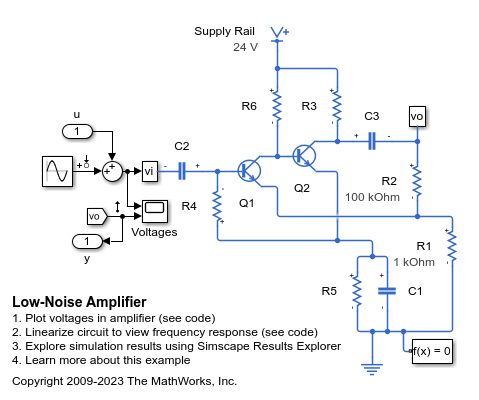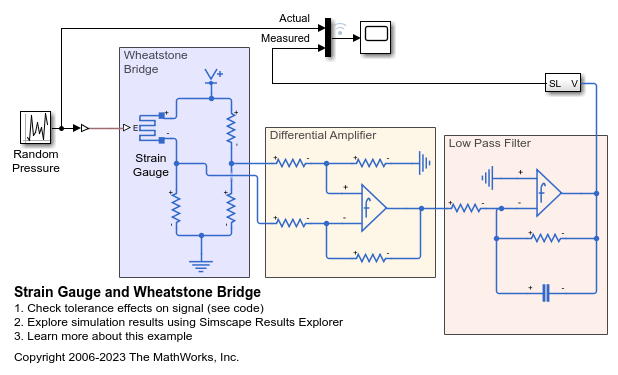Amplifiers
Use these examples to learn how to model different types of amplifiers.
Featured Examples
Audio Power Amplifier with H-Bridge
An H-bridge configuration switching audio power amplifier circuit. Switching audio power amplifiers are more efficient than conventional power amplifiers as switching devices are operating only in the fully-on and fully-off states. This audio power amplifier uses a 1MHz switching frequency and has a PI feedback controller to ensure that output voltage tracks the 2kHz and 2.5kHz sine wave inputs. The power spectrum is plotted in the Spectrum Analyzer, and can be used to inform selection of controller and filter parameters.
Class-E RF Amplifier
A class-E RF amplifier with circuit parameters chosen for an 80m wavelength. Class-E amplifiers achieve high efficiency levels as the MOSFETs never have simultaneously high Vds and Ids. The load network is used to shape the voltage and current waveforms. This model can be used to verify correct operation and to support component selection. Correct operation of the circuit is particularly sensitive to source resistance, R_source. The capacitance parameters for the two MOSFETs are representative for an FQA11N90 device.
Differential Pair Amplifier
A differential pair amplifier circuit. The circuit can be used to explore the properties of a differential pair amplifier. The model can be tested using differential and common-mode inputs. The balanced output has zero gain in common-mode provided that the two transistors have identical properties.
Low-Noise Amplifier
A typical low-noise audio amplifier circuit. Resistor R2 provides negative feedback to stabilize the overall amplifier gain, making it independent of transistor open-loop forward transfer gain. Circuit gain is approximately defined by (R1+R2)/R1 = 101. The simulation shows that it takes the circuit a few seconds to settle to its steady operating point, and that the output is initially clipped. Input u and output y are included to support linearization.
Model Operational Amplifier with Noise
Incorporate noise into an electrical simulation. The circuit models an amplifier with a high-frequency roll off frequency of 10MHz. The Band-Limited Op-Amp block adds the noise. The Voltage Source block, Vn, specifies an equivalent voltage noise density of 20 nV/Hz^0.5. You can also add the thermal noise from the resistors R1 and R2 by setting the Noise mode parameter of the two Resistor blocks to Enabled. However, running this model with different combinations of noise sources shows that the main source of noise is the equivalent noise voltage.
Strain Gauge and Wheatstone Bridge
How to model a strain gauge and measurement amplifier. The strain gauge forms one leg of a Wheatstone bridge, which is connected to a differential amplifier. A second op-amp is then used to both amplify and apply a low-pass filter to the measurement signal. The op-amps are modeled at a system level, with the user specifying parameters such as open-loop bandwidth, gain and maximum slew rate. In this circuit, the dynamics are primarily set by the low-pass filter. The op-amp bandwidth and maximum slew rate have little impact on the step response.
RF Power Amplifier Characterization Test Harness
Defines a test harness to estimate a non-linear behavioral model of a RF power amplifier from a Simscape™ Electrical™ simulation model.
RF Transistor IV Characteristics Test Harness
Defines a test harness to estimate the I-V characteristics of a bipolar transistor from a Simscape™ Electrical™ simulation model.
Switching Audio Power Amplifier
A switching audio power amplifier circuit. Switching audio power amplifiers are more efficient than conventional power amplifiers as switching devices are operating only in the fully-on and fully-off states. This audio power amplifier uses a 1MHz switching frequency and has a PI feedback controller to ensure that output voltage tracks the 2kHz and 2.5kHz sine wave inputs. The power spectrum is plotted in the Spectrum Analyzer, and can be used to inform selection of controller and filter parameters.
MATLAB Command
You clicked a link that corresponds to this MATLAB command:
Run the command by entering it in the MATLAB Command Window. Web browsers do not support MATLAB commands.
Seleziona un sito web
Seleziona un sito web per visualizzare contenuto tradotto dove disponibile e vedere eventi e offerte locali. In base alla tua area geografica, ti consigliamo di selezionare: .
Puoi anche selezionare un sito web dal seguente elenco:
Come ottenere le migliori prestazioni del sito
Per ottenere le migliori prestazioni del sito, seleziona il sito cinese (in cinese o in inglese). I siti MathWorks per gli altri paesi non sono ottimizzati per essere visitati dalla tua area geografica.
Americhe
- América Latina (Español)
- Canada (English)
- United States (English)
Europa
- Belgium (English)
- Denmark (English)
- Deutschland (Deutsch)
- España (Español)
- Finland (English)
- France (Français)
- Ireland (English)
- Italia (Italiano)
- Luxembourg (English)
- Netherlands (English)
- Norway (English)
- Österreich (Deutsch)
- Portugal (English)
- Sweden (English)
- Switzerland
- United Kingdom (English)








